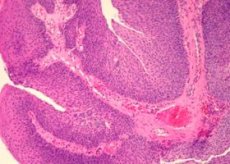Medical expert of the article
New publications
Papilloma of the conjunctiva
Last reviewed: 07.07.2025

All iLive content is medically reviewed or fact checked to ensure as much factual accuracy as possible.
We have strict sourcing guidelines and only link to reputable media sites, academic research institutions and, whenever possible, medically peer reviewed studies. Note that the numbers in parentheses ([1], [2], etc.) are clickable links to these studies.
If you feel that any of our content is inaccurate, out-of-date, or otherwise questionable, please select it and press Ctrl + Enter.

Pedunculated conjunctival papilloma
It is caused by the human papillomavirus (types 6 and 11), which can be transmitted from mother to baby at birth through an infected vagina.
Pedunculated conjunctival papilloma manifestations may be early, after birth, or years later. Papillomas, which may be numerous and sometimes bilateral, are most often located on the palpebral conjunctiva, fornix, or caruncle.
Treatment of small lesions is not necessary, as they often resolve spontaneously. Large lesions are removed surgically or with cryotherapy. Additional treatments to prevent recurrence include subconjunctival alpha interferon, topical mitomycin C, or oral cimetidine (tagamet).
"Sessile" papilloma of the conjunctiva
"Sessile" (neoplastic) papilloma is not contagious. Manifestations of "sessile" papilloma on the conjunctiva usually occur in middle age. Conjunctival papillomas are usually single, unilateral formations, most often located on the bulbar and perilimbal conjunctiva.
Treatment: surgical removal.
What do need to examine?
How to examine?
What tests are needed?
Who to contact?

